
Alexandre-François Desportes stands as a pivotal figure in French art history, particularly celebrated for his mastery in depicting animals, hunting scenes, and opulent still lifes. Flourishing during the late Baroque and early Rococo periods, his career spanned the reigns of Louis XIV and Louis XV, leaving an indelible mark on the artistic landscape of France. His meticulous observation of nature, combined with a dynamic sense of composition and a rich palette, established him as a preeminent painter of his time, influencing decorative arts and animal painting for generations.
Early Life and Flemish Foundations
Born on February 24, 1661, in the small village of Champigneulle in the Ardennes region of France, Desportes's journey into the world of art began relatively early. Recognizing his talent, his family sent him to Paris to pursue formal training. There, he entered the studio of Nicasius Bernaerts, a Flemish painter who had himself been a pupil of the renowned Antwerp master, Frans Snyders. This connection was crucial, immersing the young Desportes in the rich traditions of Flemish animal and still life painting.
Bernaerts, carrying forward the legacy of Snyders, specialized in depicting animals with vigour and realism. Under his tutelage, Desportes honed his skills in observation and precise rendering. The Flemish school, particularly artists like Snyders and Jan Fyt, was celebrated for its dynamic compositions, often featuring dramatic hunts or abundant displays of game and produce. Desportes absorbed these influences, learning to capture the textures of fur and feather, the tension of the chase, and the lushness of nature's bounty. His training emphasized direct study from life, a practice he would maintain throughout his career.
Unlike many contemporaries who might have focused solely on historical or mythological subjects favoured by the French Academy at the time, Desportes gravitated towards subjects grounded in the natural world. His apprenticeship with Bernaerts solidified his interest in animals and the outdoors, setting the stage for his future specialization. This Flemish grounding provided him with a technical proficiency and a stylistic vocabulary distinct from the more purely French traditions exemplified by artists like Charles Le Brun, the dominant figure at the Academy during Desportes's formative years.
The Polish Interlude and Return to France
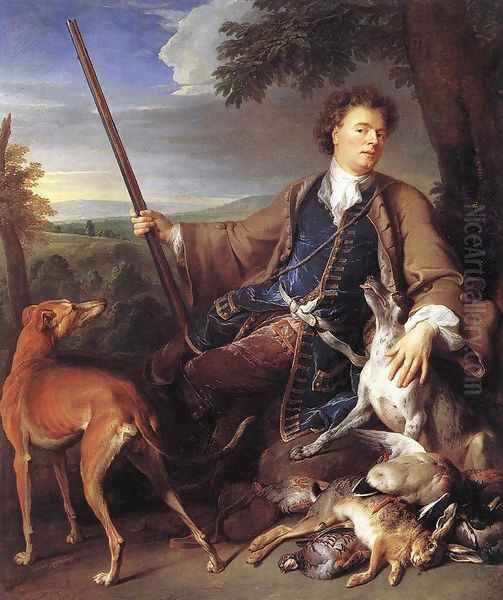
Desportes's early career took an interesting detour. Around 1695, he traveled to Poland, having secured an opportunity at the court of King John III Sobieski. Initially, his work there focused on portraiture, capturing the likenesses of the King and members of the Polish aristocracy. This period, though relatively brief (lasting until Sobieski's death in 1696), provided Desportes with valuable experience in courtly patronage and likely broadened his artistic horizons.
Working in a different cultural and artistic environment, even primarily as a portraitist, would have exposed him to varied tastes and expectations. However, portraiture was not his ultimate calling. Upon his return to France, Desportes made a decisive shift in his artistic focus. He largely abandoned portrait painting, dedicating himself instead to the genres where his true passion and talent lay: animal painting, hunting scenes, and still life.
This return marked the beginning of his ascent within the French art world. Armed with the technical skills from his Flemish training and the experience gained abroad, he began to produce works that catered to the tastes of the French aristocracy, whose lives often revolved around hunting and the management of grand estates. His ability to depict animals with lifelike accuracy and scenes of the hunt with dramatic flair quickly garnered attention.
Gaining Royal Favour: Painter to Kings
Desportes's return to France coincided with the later years of Louis XIV's reign, a period characterized by magnificent royal patronage of the arts. His specialization in hunting scenes and animal portraiture perfectly aligned with the interests of the King and the court. Louis XIV was an avid hunter, and the royal hunt was an elaborate ritual, central to court life at Versailles and other royal residences like Fontainebleau and Marly.
Desportes's skill in capturing the energy of the hunt and the noble bearing of the royal hounds did not go unnoticed. He soon attracted the attention of the King himself. His ability to render specific animals, particularly the King's favourite hunting dogs, with accuracy and personality earned him significant commissions. He was tasked with creating portraits of these prized animals, immortalizing them in paint.
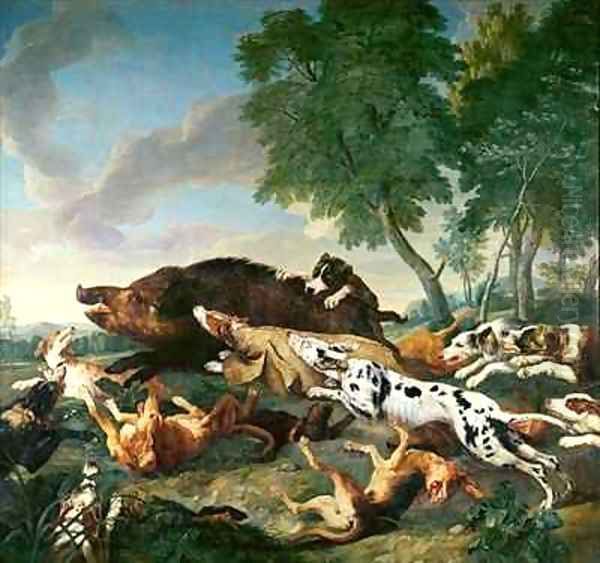
His growing reputation led to his formal acceptance into the prestigious Académie Royale de Peinture et de Sculpture. He was received (agréé) in 1699, presenting his Self-Portrait as a Huntsman as his reception piece. This remarkable work, now housed in the Louvre, depicts the artist confidently posing with his dogs and hunting gear against a landscape backdrop, showcasing his mastery of portraiture, animal painting, and landscape all in one canvas. It served as a powerful statement of his artistic identity and skill.
In 1704, Desportes achieved the status of a full Academician (Académicien). This membership cemented his position within the official art establishment, granting him exhibition privileges at the Salon and further enhancing his prestige. He became a favoured artist not only of Louis XIV but later of his successor, Louis XV, continuing to receive royal commissions throughout the subsequent reign.
The Painter of the Royal Hunt
Desportes earned the esteemed title of "Peintre de la Vénerie," essentially the official painter of the royal hunt. This was more than just an honorary designation; it reflected his active participation in and documentation of this central aspect of courtly life. He frequently accompanied the royal hunting parties, often equipped with a small notebook to make rapid sketches directly from nature (d'après nature).
This practice of sketching outdoors was somewhat innovative for the time and fundamental to the freshness and accuracy of his finished paintings. He would capture the fleeting moments of the chase, the postures of dogs in action, the appearance of game animals like deer, boar, and foxes, and the details of the landscape. These sketches, executed with immediacy and keen observation, formed the basis for the larger, more elaborate compositions he later created in his studio.
His hunting scenes, such as the Wild Boar Hunt or Hallali de cerf (The Kill of the Stag), are characterized by their dynamic energy, complex compositions, and detailed rendering of animals and environment. He masterfully conveyed the excitement and sometimes the brutality of the hunt, placing packs of straining hounds and their quarry within convincing landscape settings. These works were highly sought after for decorating royal palaces and the chateaux of the nobility, serving both as records of aristocratic pastime and as impressive displays of artistic virtuosity.
His connection to the hunt extended beyond depicting the chase itself. He was often called upon to paint the animals after the hunt, documenting the day's spoils. These studies further demonstrate his commitment to anatomical accuracy and his ability to render different textures, from the rough coat of a boar to the sleek fur of a deer.
Master of Animal Portraiture
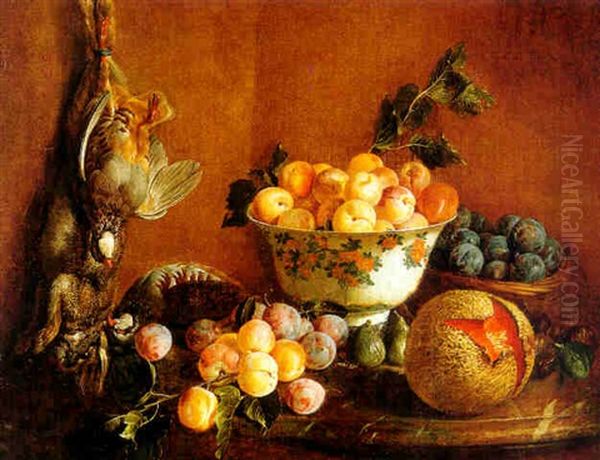
While his hunting scenes were dramatic, Desportes also excelled at more focused depictions of animals, particularly dogs. His portraits of Louis XIV's and Louis XV's hounds are among his most celebrated works. Paintings like Bonne, Nonne et Ponne, Dogs of King Louis XIV go beyond mere representation; they capture the individual character and temperament of each animal. He rendered their coats, musculature, and expressions with remarkable sensitivity and detail.
His approach to animal painting was rooted in careful observation. He maintained a menagerie of animals and birds, allowing him to study their forms and movements continuously. This dedication to firsthand study distinguishes his work, lending it an authenticity and vitality often lacking in more stylized animal depictions. He painted not just dogs, but also exotic birds, farm animals, and wild creatures, often incorporating them into his still lifes and decorative compositions.
His skill was recognized internationally. During a visit to England in 1712-1713, he received commissions from members of the English aristocracy, further testament to his reputation. His ability to capture the essence of an animal, whether a prized hunting dog or a creature destined for the table, set a high standard for the genre. He can be seen as a key figure in elevating animal painting within the hierarchy of genres, traditionally dominated by history painting.
The Art of Still Life
Alongside his hunting scenes and animal portraits, Desportes was a prolific and accomplished painter of still lifes. Here too, the influence of his Flemish training is evident, particularly in the richness of detail and the celebration of abundance. However, his still lifes often possess a distinctively French elegance and refinement.
He painted various types of still lifes. Some feature arrangements of fruit and flowers, showcasing his ability to capture delicate textures and vibrant colours. Others focus on game and poultry, often presented as trophies of the hunt or ingredients for a feast. These works, like Still Life with Dressed Game, Meat, and Fruit (1734), display his meticulous attention to detail in rendering fur, feathers, and the glistening surfaces of prepared foods.
His compositions are typically well-balanced, often incorporating luxurious objects like silver platters or porcelain bowls, reflecting the sophisticated tastes of his patrons. While drawing on the Flemish tradition of artists like Frans Snyders or Adriaen van Utrecht, Desportes's still lifes often feel less overwhelming and more harmoniously arranged than some of their densely packed Flemish counterparts. He masterfully balanced realism with decorative effect.
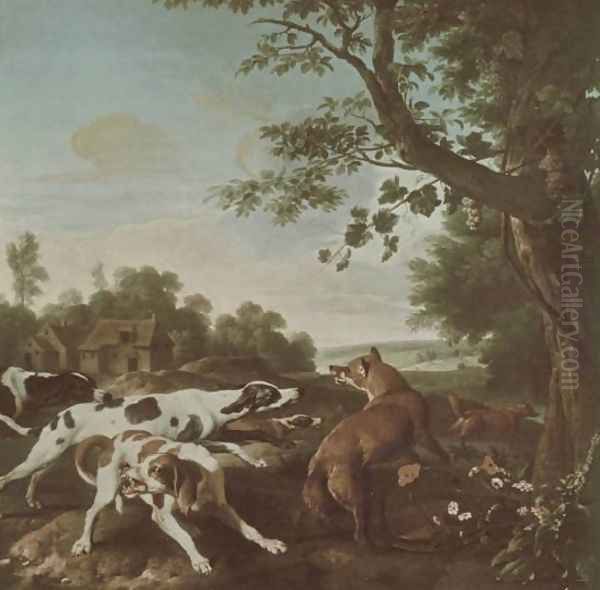
Works like Still Life with Cat (1705) and Still Life with Dog (1705) introduce a narrative element, showing animals interacting with the displayed food. These paintings combine his skills in both animal and still life painting, adding a touch of liveliness and anecdote to the arrangements. His still lifes contributed significantly to his fame and were highly valued for decorating dining rooms and salons.
Decorative Commissions and Tapestry Design
Desportes's talents extended beyond easel painting into the realm of large-scale decorative work. He received numerous commissions to create decorative panels, overdoors (dessus-de-porte), and other painted elements for royal residences, including the Château de Versailles, the Château de Marly, the Château de Meudon, and later, the Château de Compiègne and Choisy for Louis XV.
These decorative works often featured animals, landscapes, and floral motifs, seamlessly integrated into the architectural settings. They required a different approach than easel painting, demanding consideration of perspective, scale, and the overall decorative scheme of the room. Desportes proved adept at adapting his style to these requirements, creating works that were both visually engaging and harmoniously suited to their surroundings.
Furthermore, Desportes made significant contributions to tapestry design, particularly for the renowned Gobelins and Beauvais manufactories. He provided cartoons (full-scale painted designs) for several important tapestry series. Among the most famous are the Anciennes Indes (Old Indies) and the Nouvelles Indes (New Indies) series, woven at the Gobelins manufactory. These tapestries depicted exotic animals and plants, reflecting the era's fascination with faraway lands.
While the original Anciens Indes designs were based on paintings brought back from Brazil by the Dutch artist Albert Eckhout in the 17th century, Desportes was commissioned to rework and supplement these designs, adapting them to contemporary tastes. His contributions infused the series with his characteristic attention to natural detail and lively composition. His designs influenced tapestry production for decades, demonstrating his versatility and impact across different artistic media. His work in this field connected him to the broader tradition of French decorative arts, shaped earlier by figures like Charles Le Brun, who had overseen the Gobelins manufactory under Louis XIV.
Style: Realism, Dynamism, and Elegance
Desportes's artistic style is characterized by a blend of meticulous realism, inherited from his Flemish training, and a sense of dynamism and elegance suited to French tastes. His primary commitment was to truthfulness in representation, based on direct observation of nature. His numerous surviving sketches attest to this dedication, capturing animals and plants with scientific precision yet artistic flair.
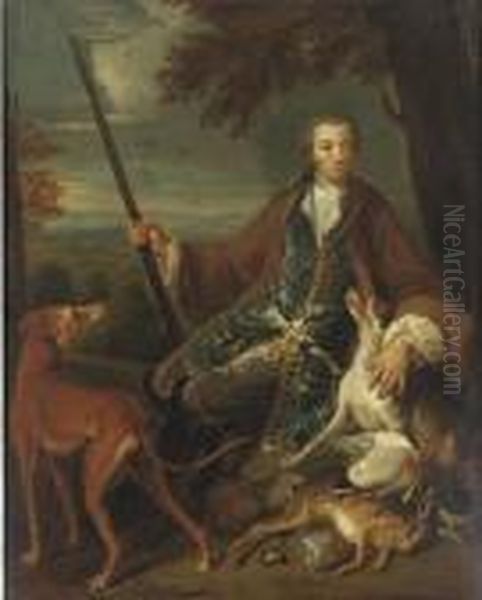
In his finished paintings, this realism is combined with strong compositional structures. His hunting scenes are often filled with movement and energy, using diagonal lines and dramatic groupings of figures to convey the excitement of the chase. His still lifes, while detailed, are carefully arranged for balance and visual appeal, often employing sophisticated colour harmonies.
His palette was typically rich and varied, capable of rendering the diverse textures of animal fur, feathers, fruit, flowers, and fabrics. He handled light and shadow effectively to model forms and create depth, though perhaps without the intense chiaroscuro of some earlier Baroque masters like Caravaggio or Rembrandt. His brushwork could be both precise in rendering details and broader, more fluid in suggesting movement or atmospheric effects.
Compared to his main contemporary and rival in the field of animal and hunting painting, Jean-Baptiste Oudry (1686-1755), Desportes's style is often considered slightly more objective and less overtly dramatic. Oudry, who also enjoyed immense royal patronage, sometimes infused his works with a greater sense of theatricality or anthropomorphism, particularly in his animal depictions. Both artists, however, dominated the genre in 18th-century France, building upon the foundations laid by earlier Flemish and French painters and setting new standards for naturalistic representation.
While firmly rooted in the Baroque tradition, Desportes's work also anticipates elements of the emerging Rococo style, particularly in its decorative qualities and lighter palette in some later works. However, he never fully embraced the frivolity or asymmetry characteristic of high Rococo artists like François Boucher or Jean-Honoré Fragonard. His art retained a certain groundedness and fidelity to nature throughout his career.
Workshop, Legacy, and Influence
Like many successful artists of his time, Desportes maintained an active studio to help manage his numerous commissions. His son, Claude-François Desportes (1695-1774), also became a painter, training under his father and eventually inheriting the studio contents. Claude-François continued to work in similar genres, primarily animal and still life painting, and played a role in preserving his father's legacy, though he never achieved the same level of fame or artistic brilliance.
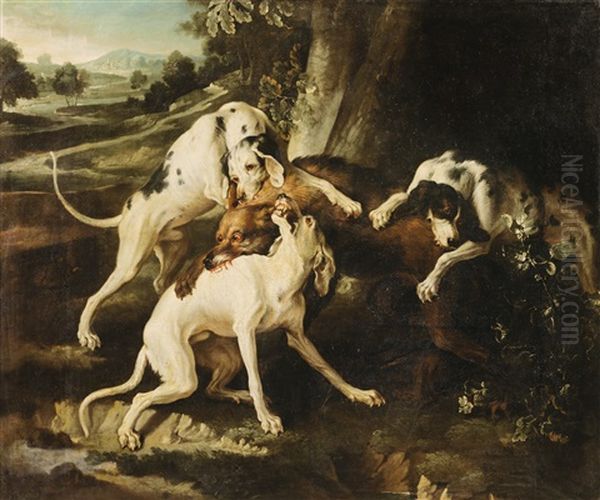
Upon Alexandre-François Desportes's death in Paris on April 20, 1743, his studio contents, including a vast collection of his preparatory sketches and studies from nature, were preserved. Many of these were later acquired by the Sèvres porcelain manufactory to serve as models for decoration, and a significant portion eventually entered the collections of the Louvre Museum. These studies provide invaluable insight into his working methods and his dedication to observing the natural world directly.
Desportes's influence was considerable. He, along with Oudry, defined animal and hunting painting in France for much of the 18th century. His emphasis on direct observation and naturalism impacted subsequent generations of artists working in these genres. His decorative paintings and tapestry designs contributed significantly to the opulent interiors of royal and aristocratic residences.
His contemporaries included not only Oudry but also prominent portraitists like Hyacinthe Rigaud and Nicolas de Largillière (who also painted still lifes), flower painters like Jean-Baptiste Monnoyer, and decorative painters involved in royal projects like Charles de La Fosse and Antoine Coypel. While working within his specific specializations, Desportes operated within this vibrant artistic milieu, contributing to the overall richness of French art during the Grand Siècle and the subsequent Régence and reign of Louis XV. Figures like Antoine Watteau were also his contemporaries, though Watteau focused on the very different genre of the fête galante.
Today, Desportes's works are held in major museums worldwide, including the Louvre in Paris, the Musée de la Chasse et de la Nature (Museum of Hunting and Nature) in Paris, the Wallace Collection in London, the Metropolitan Museum of Art in New York, and many others. His paintings continue to be admired for their technical skill, their lively depiction of animals, and their evocative portrayal of the hunt and the natural world.
Conclusion: An Enduring Vision of Nature
Alexandre-François Desportes carved a unique and enduring niche for himself in the competitive art world of 17th and 18th-century France. By combining the robust realism of his Flemish training with French elegance and a profound dedication to observing nature firsthand, he became the preeminent master of animal painting and hunting scenes. His close relationship with the French monarchy, serving both Louis XIV and Louis XV, ensured his prominence and provided him with unparalleled opportunities for commissions, from intimate portraits of royal hounds to grand decorative schemes and influential tapestry designs.
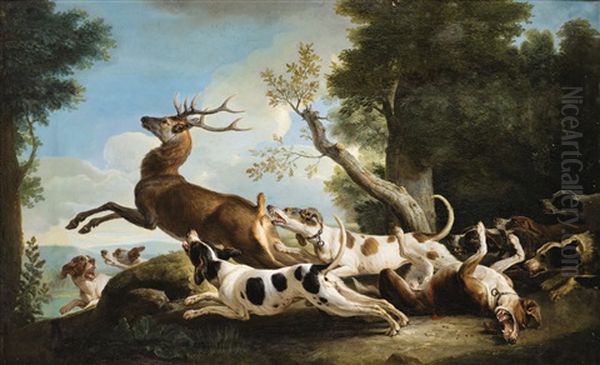
His legacy lies not only in the beauty and skill of his individual works but also in his role in elevating the status of animal and still life painting. His commitment to sketching d'après nature brought a new level of authenticity and vitality to these genres. While sometimes overshadowed in popular recognition by his contemporary Oudry, or by the masters of history painting or Rococo fantasy, Desportes's contribution remains fundamental to understanding the art and culture of his time. His paintings offer a vivid window into the aristocratic pursuits, decorative tastes, and deep appreciation for the natural world that characterized the age, captured with the eye of a keen observer and the hand of a master craftsman.